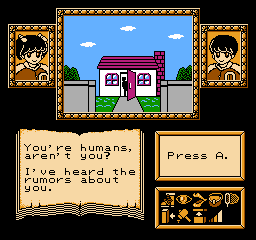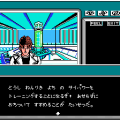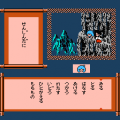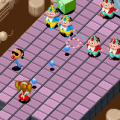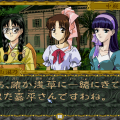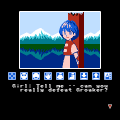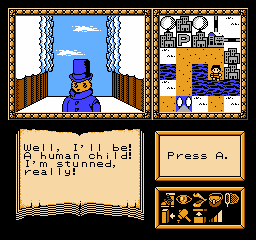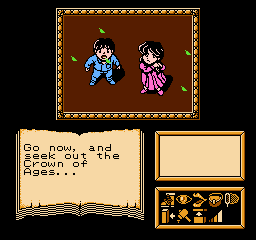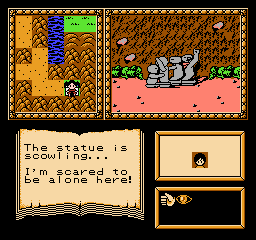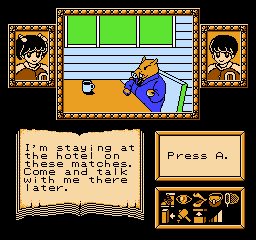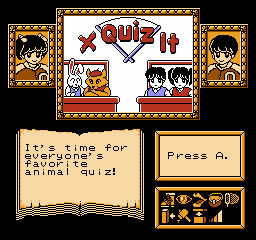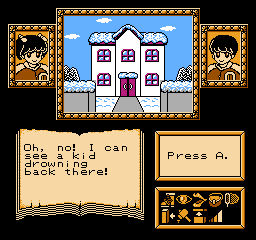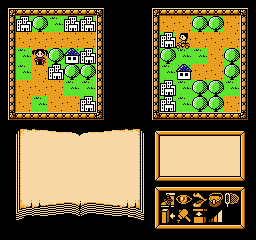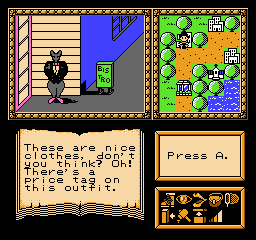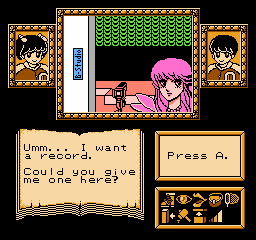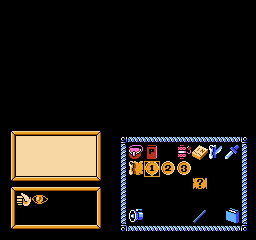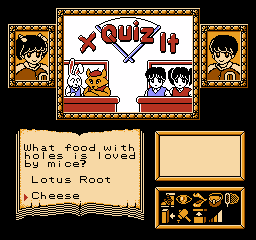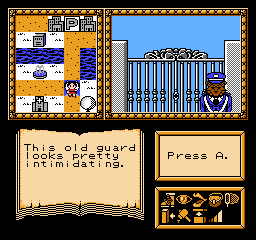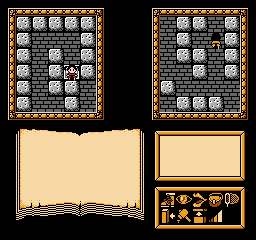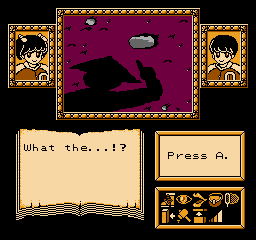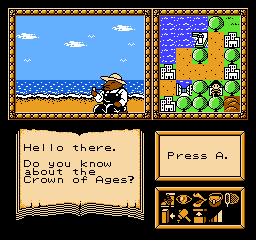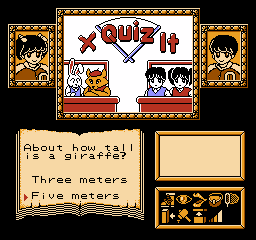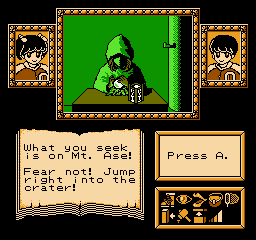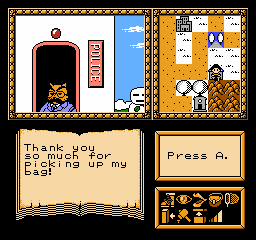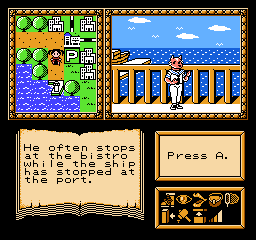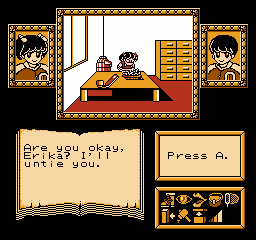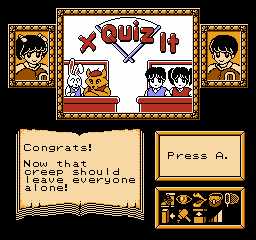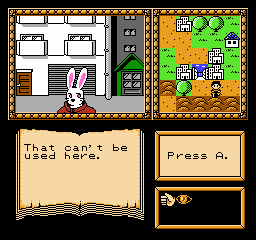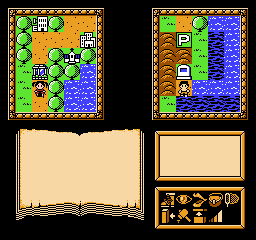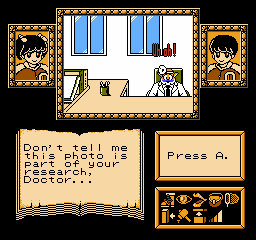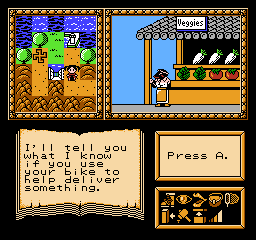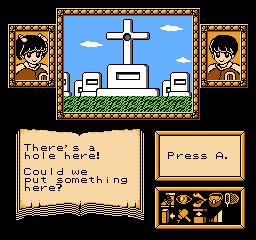
Japanese Cover
In between the action and role-playing games that they produced during their early years, Atlus of Megami Tensei fame dabbled in the burgeoning adventure game genre with Erika to Satoru no Yume Bouken (or “Erika and Satoru’s Dream Adventure“). Although it attempts something fairly interesting with a focus on co-operative play with two controllable characters, the end result is an unremarkable adventure marred by repetitive situations and poor conveyance.
On the night before their summer vacation ends, siblings Erika and Satoru are wishing they could have just one more day off when they notice a cat in human clothes outside. They follow the cat and are soon whisked away to a strange land full of animal people, where they are told to find the Crown of Ages, which will grant them true joy. Guided only by those words, Erika and Satoru set out on a journey across many towns in search of the Crown.
Erika and Satoru’s Dream Adventure is an adventure game where you progress by talking to people, finding items and solving simple puzzles with those items or info gained from the conversations you’ve had. You explore the world from a top-down perspective, while entering locations marked by unique tiles brings you into a first-person perspective from which you can interact with the area via a selection of commands (represented by visual icons). Helpfully, the cursor automatically picks between points of interest so you don’t need to go pixel-hunting to find specific areas.
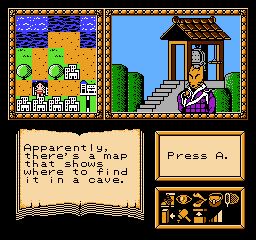
Where things get interesting is that this is a co-operative adventure game. Erika and Satoru are two separate characters, each inhabiting their own on-screen window, and can be controlled by two players if you pick the co-op option from the main menu. They have a shared item bag, so you can have them go to different locations and encounter scenarios where one character picks up an item which can immediately be used by another character. Both characters are mostly the same, except that Satoru can swim indefinitely while Erika can only swim for around 15 tiles before needing to stop.
If you’re playing on your own, you can only control one character at a time and you swap between them by pressing Select. It’s a bit clunky to get working, especially if you’re trying to swap between them while inhabiting separate locations, but it can be gotten used to after a while. Conceptually, it’s a great way of streamlining exploration and backtracking by swapping between characters and solving puzzles at different places at the same time.
However, this concept isn’t utilized all that much beyond that basic use, with puzzles never demanding you work in tandem except to simply progress more quickly. Even doing that little is something of a rarity. You’ll often come across locations where you need both characters in order to head inside or to talk to a particular person, which results in having to drag two characters to the same place before you can make any progress. It’s rather ineffectual in co-op and a waste of the player’s time when done solo.
Another notable mechanic is the quiz show. Fairly regularly, you’ll be forced to take part in a quiz show, where you must answer a handful of animal-themed trivia questions. If you get a question wrong, you’ll have to start over (though sometimes you’ll get the item you need for your troubles anyway); and that includes repeating the preceding dialogue exchange, which gets pretty tedious. While the questions are randomized, they do tend to repeat so you should be able to get through them by learning the answers.
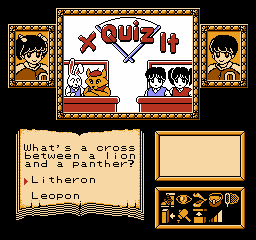
It’s pretty funny how frequently it comes up, being used to resolve situations like a criminal mugging an old lady or in ridiculous scenarios such as people who previously promised to give information suddenly deciding you have to pass the quiz first. Otherwise, it’s a decent little pace-breaker but one that overstays its welcome without adding anything new over time, and that’s sadly a problem with Erika and Satoru’s Dream Adventure in general.
Each of the game’s five chapters has you doing the same thing: you head to a town and find either information or an artefact related to the Crown of Ages, solve light puzzles with the odd item, take part in a few quizzes, and then take the train to the next town once you’ve found everything. There’s little variation in what you do specifically, and there are too many things that get repeated such as exploring caves or needing to rest to let time arbitrarily pass until you can talk to someone.
This wouldn’t be so bad if the game had more going on, but the odd amusing moment or bit of banter isn’t enough to rescue a dull adventure that spends most of its runtime spinning its wheels. It’s only near the end when things start getting interesting, and even that’s going to take a lot of busywork to reach due to the tedious nature of progression.
Often times, you’ll only be able to trigger being able to talk to a character at a place or do something by triggering a specific event somewhere else. While this can occasionally have a logic to it, by only learning of a person’s existence from somebody else, there’s no conveyance as to why going to this specific spot will allow Erika and Satoru to do things they couldn’t already do. In general, the game poorly conveys what and when you’re able to do things, making it difficult to know how to make any progress even when you do take notes. This is one of those adventure games where you have to take a lot of notes and try everything to get anywhere, and that makes it hard to recommend unless you’re into that specific sort of adventure game.
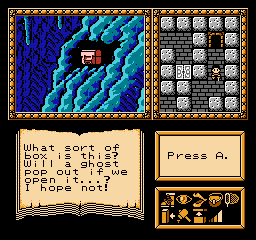
At the very least, it’s got some good presentation going for it. The graphics are fairly good, providing colorful locales populated with cute animal people and different locales as the game goes on to provide some visual variety. However, the highlight by far is the music by Hirohiko Takayama (known for his work on other NES games such as Xexyz, The Karate Kid and Friday the 13th). It utilizes Namco’s 163 audio expansion chip to provide 8 additional sound channels of wavetable synthesis, and is the only other Famicom game apart from King of Kings to use all of these channels for the music. As a result, the adventure is scored by an evocative soundscape with beautifully full arrangements that work effectively for creating catchy upbeat tunes and quiet moodier pieces throughout.
If Erika and Satoru’s Dream Adventure is remembered for anything, it’s for the infamous unlockable message included by a programmer known only as Hidemushi. This message, which is accessed by performing a truly bizarre series of commands at the very end of the game, contains profane rants about members of the development team and their sexual habits.
Links:
A page on how to access Hidemushi’s message, along with a translation of the message and other small secrets: https://tcrf.net/Erika_to_Satoru_no_Yume_Bouken
